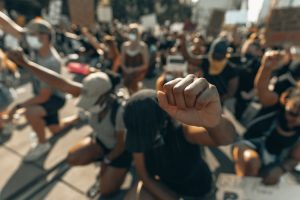In a world where the death of George Floyd and the emergence of the Black Lives Matter movement have become part of the national lexicon, we have to examine how racial literacy is applied in the classroom. Racial literacy is a concept developed by sociologist France Winddance Twine and which refers to a set of practices designed to teach adults and children how to recognize and respond to forms of everyday racism (Twine, 2004) .
Read on for part 2 of Inside the Virtual Classroom, where this week three of our instructors share their thoughts about the impact of racial literacy in their mindfulness teaching.
Q: What is your awareness of how racial literacy impacts your teaching? If it shows up in the classroom, how do you address it?
Lina Blanchet:
Racial literacy in the realm of education and mindfulness has been a focus of study and exploration for me for the past two years, more so in the past last year specifically. This stemmed from recognizing a clear need to attend to how white supremacy directly impacts student learning and experiences of trauma and ACES (Adverse Childhood Experiences).
With this I’ve become more sensitive to and aware of ways in which systemic racial dominance infiltrates the ways we interact with each other including in the classroom. The intention has been to hold a greater sensitivity to the way I use language, to the images I use when creating slides, to the examples I use when describing mindfulness practices and their value to my students.
For example, when practicing mindfulness of breath earlier in the year and now as well, I intentionally hold an awareness of the trauma of George Floyd’s death and the connection to the breath that may be triggering for students. With this in mind, I often, particularly in the beginning weave in some trauma sensitive approaches into the meditation such as letting students know if they feel very uncomfortable that they should open their eyes and look around the room to ground their awareness and attention on 3-5 objects they see rather than the breath.
Haylee Warner:
Racial literacy shows up in the materials we use when we teach. Racial literacy has to include an awareness of what we present to the students. This means that contextual, relatable images, activities, slides, suggestions, etc, all have to be racially literate – meaning that they reinforce positive role models for all peoples and do not trigger or associate with negative stereotypes. Being mindful and aware of our own conditioned responses also requires us not to make assumptions about any students’ experiences (good or bad).
I also try to reinforce how I hold the space. Many students have experienced traumatic events and some are struggling in their efforts to integrate and process those events. We have to be mindful of how that manifests in a virtual classroom. Even though it may be difficult because often we can’t see or hear our students (they don’t turn their cameras or mics on and just chat), we still have to try and create a safe, encouraging, and supportive space.
What does that look like? It can mean practicing – no matter who is in the room – to be uplifting to the most oppressed populations so that everyone can benefit from the tools. It means being aware of implicit biases. It means building trust and understanding the importance of students relating to teachers who look like them.
Amy Edelstein:
Being racially literate in the virtual environment requires a different sensibility and awareness than in the in-person classroom. The principles are the same — being mindful of the cultural power dynamics and how they play out in a classroom (for example, the power dynamics inherent between teacher (authority) and student; between white and BIPOC, between normative gender expressions and gender nonconforming identities, and let’s not forget between men and women)–and consciously disrupting inequitable, hurtful, and unconscious biases so everyone is supported.
But in the virtual education landscape, we have to become more aware of what we cannot see. In Philadelphia schools, socioeconomic disparities as connected with race have really put many students of color at a disadvantage. With working parents or guardians, economic scarcity, and more crowded living spaces, many students of color just don’t have the focus, structure, and added support that more affluent students (whether black or white) have. For teachers who present or identify as White, being aware of economic privilege as connected with race is important and in a public school system in a city like Philadelphia, access, wealth, privilege, and race are deeply intertwined.
Here’s an example of how our awareness needs to increase in the virtual landscape and how our examples have to change in order to be as inclusive as possible, and as real and sensitive to some of our students’ home environments.
For “Seeing Freshly” our mindful eating activity, in the classroom we’d bring snacks and everyone would eat the same thing. With students at home, and possible food insecurity, we use the senses (sound, smell, touch) or mindfully drinking water rather than using a piece of food. Some students may not have extra food or be allowed to take snacks. We won’t know because we won’t be able to see that, but we need to anticipate those situations and not cause discomfort or exclusion.
In the virtual environment, you don’t necessarily know what a student’s home environment is like. They might not have windows to look out of, they might not be able to go for a walk for fresh air because of gun violence, gangs, or drugs in the neighborhood, etc. So it’s really important, when using metaphors and giving examples, to find something more universal, (Rather than “look out the window at the sky” say “find a beautiful color or shape in your room to rest your eyes on.”)
Additionally, white teachers may interact with students in ways that can be perceived as having a racial overtone or a slight. An example would be name pronunciation. Getting a student’s name right is vitally important. Why? A name is our identity. Repeated or uncorrected mispronunciation can be perceived as cultural ignorance, indifference, or disrespect. With virtual learning, we just see a written name, and it’s harder to ask students to say their name since many will not unmute themselves. So we may not know how that student pronounces their name, and we will likely make mistakes. Being racially literate means being aware of the sensitivity and wanting to have a positive, respectful, and affirming impact on your student. It means making an effort to encourage a student to correct me if I am mispronouncing and to let them know I do want to pronounce their names properly. That way it becomes “my fault” if I mispronounce and I’m happy to be corrected (I thank them aloud for correcting me) rather than their fault (for having a name that may be hard to guess how to pronounce and making the authority/teacher/person of privilege uncomfortable.)
Another issue of racial literacy and potential inequity that can arise around names is avoiding calling on students with names you may not know how to pronounce. If a teacher does that, to avoid the embarrassment of being corrected, then those students are not receiving equal encouragement, they are not being invited and welcomed to participate in class. With virtual learning, it is so hard for students to stay engaged, as instructors we want to be sure to keep extending a welcoming hand to everyone and being easy and relaxed around these issues that will inevitably arise.
These are a few of the everyday examples, which I hope gives you a sense of the sensitivity we are trying to cultivate in ourselves and the respect and care that we are trying to communicate to our students.
Next week: What are some of the most surprising challenges that students are facing?



